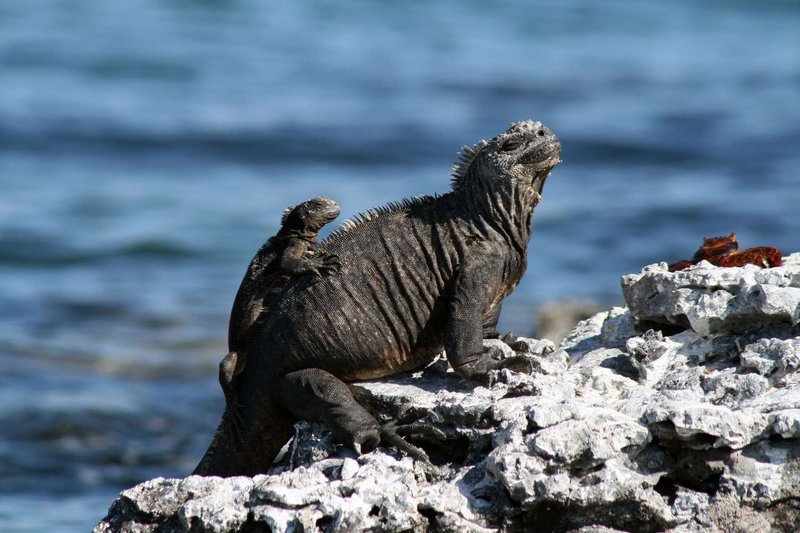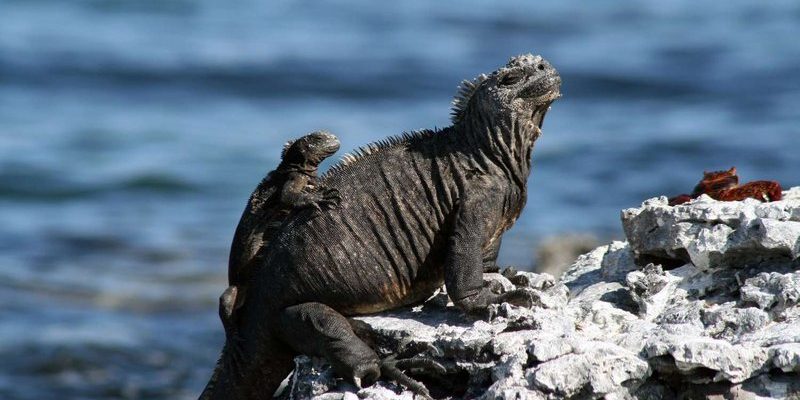
Marine iguanas are primarily found in the Galápagos Islands, an archipelago off the coast of Ecuador. Think of these islands as a living laboratory where evolution plays out in real-time. The marine iguanas here have developed unique traits to survive in their environment. They have flattened bodies and powerful limbs, making them excellent swimmers. Some might even say they’re like the superheroes of the lizard world!
Curious about their habitat beyond the Galápagos? You’re not alone. Understanding where marine iguanas live and what challenges they face can shed light on their unique adaptations. Let’s explore the various locations and conditions that make up their world!
The Galápagos Islands: The Heart of Marine Iguanas
The Galápagos Islands are synonymous with marine iguanas. This remote archipelago consists of 13 main islands, along with numerous islets, and is situated about 600 miles off the coast of Ecuador. The islands’ volcanic rock formations and rich marine ecosystem provide the perfect environment for these unique reptiles.
You might wonder, what makes the Galápagos special for marine iguanas? Well, the islands’ isolation has allowed these creatures to evolve distinct characteristics over time. Most marine iguanas are found on the larger islands, such as Isabela and Santa Cruz, where they bask on rocks and dive into the ocean to forage for algae. Here, they thrive in a delicate balance with their surroundings, often seen sunbathing or socializing in groups known as “clans.”
Interestingly, the marine iguanas’ coloration can change depending on their environment. The dark, almost black skin helps them absorb heat from the sun, making it easier for them to stay warm after swimming in cold waters. This detail is just one of many adaptations that allow these remarkable creatures to flourish in their island paradise.
How Marine Iguanas Adapt to Their Environment
Marine iguanas have some truly remarkable adaptations that help them survive in their salty marine habitat. One of their most notable traits is their ability to hold their breath while diving for food. They can dive for up to an hour, although most dives last around 10 to 15 minutes. When foraging, they can reach depths of about 30 feet, primarily targeting green and red algae.
But there’s more to their adaptations than just diving. Marine iguanas also possess specialized salt glands located near their eyes, allowing them to excrete excess salt accumulated from the seawater they ingest while eating. You might say they have built-in filters! This is crucial for their survival, as it helps them maintain a balanced internal environment.
In addition to these physical adaptations, their social behavior is fascinating too. During breeding season, male marine iguanas become incredibly competitive, displaying bright colors to attract females. This vibrant display is not just for show; it’s a signal of health and vitality, which is vital for successful mating.
Other Islands with Marine Iguanas: A Rare Sight
While the Galápagos Islands are the primary haven for marine iguanas, they exist nowhere else in the world. That doesn’t mean they don’t have some distant cousins or similar reptiles in other regions. However, if you’re hoping to spot marine iguanas outside the Galápagos, you’re out of luck. Their adaptation to marine life is so unique that they simply haven’t spread beyond these islands.
That said, some closely related species can be found on the mainland of Ecuador or throughout Central America. For example, the green iguana is a common sight in tropical areas, but it lacks the marine adaptations seen in marine iguanas. Their shared ancestry highlights the fascinating process of evolution, which has led to this stark difference in habitat and lifestyle.
If you’re planning a trip to see marine iguanas, the Galápagos Islands are your best bet. Visiting these remote lands provides a unique opportunity to observe marine iguanas in their natural habitat and appreciate their incredible adaptations firsthand.
Challenges Facing Marine Iguanas
Despite their remarkable adaptations, marine iguanas face several challenges. Climate change poses a significant threat, particularly through rising ocean temperatures and changes in algal availability. When the waters warm, the amount of algae decreases, which can impact their food supply. Imagine suddenly finding your favorite restaurant closed—frustrating, right? That’s similar to what marine iguanas may experience.
In addition to climate challenges, human activity poses risks. Tourism can sometimes lead to habitat disruption, and the introduction of non-native species can create competition for resources. Conservation efforts in the Galápagos have been implemented to help protect marine iguanas and their habitat. These efforts focus on regulating tourism, controlling invasive species, and conducting research to monitor their populations.
It’s essential to spread awareness about these challenges. Understanding what marine iguanas are up against can help inspire efforts to protect them and their unique ecosystems.
The Importance of Marine Iguanas in Ecosystems
Marine iguanas play a crucial role in their ecosystems. As herbivores, they help maintain the balance of algal growth in marine environments. By feeding on algae, they prevent overgrowth that could disrupt local marine habitats. This benefit is vital not just for the iguanas but for the entire ecosystem.
An example of their role can be visualized like a well-tended garden. If you let weeds (or in this case, algae) grow unchecked, they take over and choke out native plants. Marine iguanas ensure that the backyard of their ocean home remains healthy and vibrant.
Additionally, they’re part of the food web, serving as prey for birds of prey and other local predators. By contributing to the balance of their environment, marine iguanas help maintain biodiversity, which is essential for the health of ecosystems.
How to Observe Marine Iguanas
If you’re eager to see marine iguanas up close, planning a trip to the Galápagos Islands is the way to go. There are numerous tour operators offering guided excursions, some of which focus specifically on wildlife watching.
When observing marine iguanas, it’s essential to remain respectful of their space. Here are a few tips to enhance your experience:
- Keep your distance: Observing from afar helps prevent stress on the animals.
- Stay on designated paths: This minimizes your impact on their habitat.
- Be curious but patient: Take your time in observing their behaviors—each moment is a learning opportunity!
As you watch these reptiles basking in the sun or diving into the clear waters, you’ll likely find yourself captivated by their easy grace. It’s a truly unique experience and a reminder of the wonders of nature.
Closing Thoughts: A Unique Creature Worth Protecting
Marine iguanas are a testament to the incredible adaptability of life on Earth. Found only in the Galápagos Islands, these reptiles are extraordinary in their ability to live both on land and in the ocean. As unique as they are fascinating, marine iguanas remind us of the delicate balance of ecosystems and the importance of conservation efforts.
If there’s one takeaway from our journey through the world of marine iguanas, it’s this: we all play a role in protecting these remarkable creatures and their habitats. From understanding their challenges to supporting conservation initiatives, every little bit helps. So, let’s celebrate these amazing lizards and do our part to ensure they thrive for generations to come!

